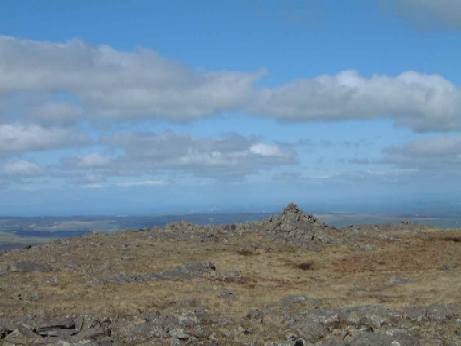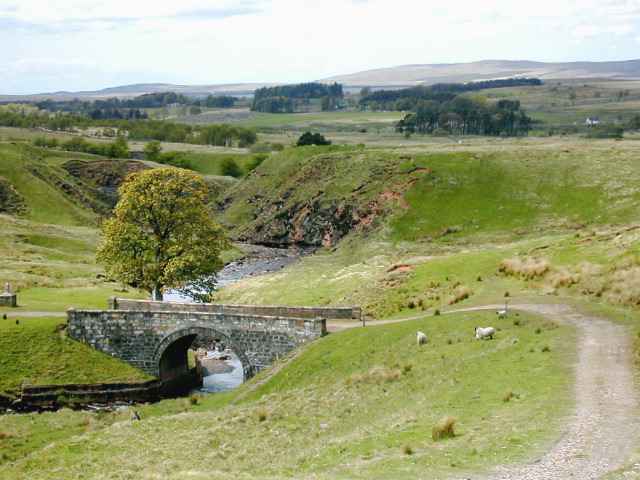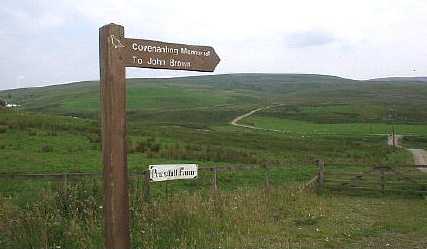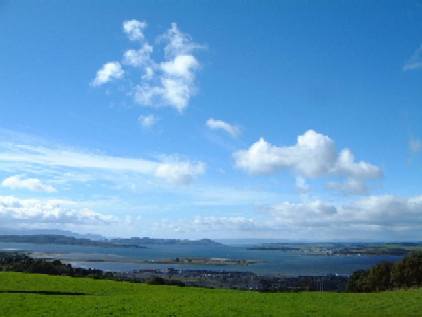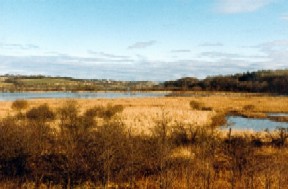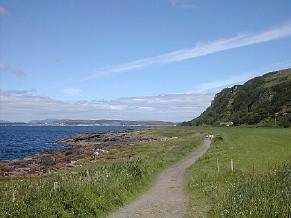
Location and Access
 Portencross (NS 175 488) is at Farland Head which projects into the Clyde Estuary just south of the Cumbrae Islands. At the cross roads on A78 on the northern edge of Seamill, take B7048 west for 2km to the road end where there is a large free car park and seaside picnic place with panoramic views of the Clyde. The historic Castle and port lie close by. A track for use on foot or cycle follows the shoreline north for 2km to the BNFL nuclear power station. This coastal walk or cycle can be extended to a very attractive and level 10km round trip past rocky shoreline, mud flat, scrub, marsh, cliff face, mature woodland and pastoral and arable farmland. The route, which is described below, is mainly on off road tracks and way-marked cycleways. Please respect any requirements from the power station operators by whose property the route passes at one stage.
Portencross (NS 175 488) is at Farland Head which projects into the Clyde Estuary just south of the Cumbrae Islands. At the cross roads on A78 on the northern edge of Seamill, take B7048 west for 2km to the road end where there is a large free car park and seaside picnic place with panoramic views of the Clyde. The historic Castle and port lie close by. A track for use on foot or cycle follows the shoreline north for 2km to the BNFL nuclear power station. This coastal walk or cycle can be extended to a very attractive and level 10km round trip past rocky shoreline, mud flat, scrub, marsh, cliff face, mature woodland and pastoral and arable farmland. The route, which is described below, is mainly on off road tracks and way-marked cycleways. Please respect any requirements from the power station operators by whose property the route passes at one stage.
![]() Adequate parking. Very rough track beyond locked gate at end of public road (NS 176 490).
Adequate parking. Very rough track beyond locked gate at end of public road (NS 176 490).
![]() Easy link to the Ardrossan to Largs coastal cycle path. Easy 10km round cycle on tracks and quiet byways.
Easy link to the Ardrossan to Largs coastal cycle path. Easy 10km round cycle on tracks and quiet byways.
Birds
The path from Portencross runs along a raised beach though meadow backed by a steep escarpment whose lower reaches are heavily wooded. The shoreline is rocky at this stage. Sea viewing can be rewarding. Black Guillemot and other seabirds favour the projecting power station service pier. Stonechat, Whitethroat and Sedge Warbler inhabit the scrub and the escarpment has breeding Fulmar and Buzzard. The woodland attracts summer visiting warblers such as Blackcap and Chiffchaff. Raven, Great Spotted Woodpecker, Tawny and Barn Owl are in the area. The range of birds seen can be extended by following the circular route.
The Castle
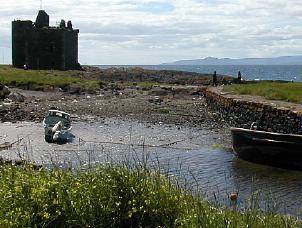 The castle is of historic importance to Scotland and vital efforts are being made to preserve it. The following are extracts from the interesting information board:
The castle is of historic importance to Scotland and vital efforts are being made to preserve it. The following are extracts from the interesting information board:
The castle’s roof blew off during a violent storm in 1739, but its walls remain intact. Four storeys high, the interior features a barrel-vaulted ceiling. It boasted two kitchens on the first two floors, and from the first floor, a circular staircase leads to the top. The L-shaped plan of Portencross castle is the first of these early buildings in that form. Abandoned, it remains remarkably intact despite an absence of urgently required maintenance.
Update 2010: As a result of a successful fund-raising campaign, the castle has been extensively restored. It is now open to the public during selected periods in the warmer months.
Extended Route
From the style or gate at the northern end of the raised beach path, continue along a well-made road past the power station complex for 2.5km round to where the way-marked coastal cycleway crosses. There are wetlands within the BNFL site, a haunting natural setting for the impressive reactor buildings in the background. A bubbling outflow and mudflats lie to seaward with seascapes past Great Cumbrae and Largs to the mountains beyond. Turn south along the cycle route towards Seamill and follow it as it weaves along tracks and byways through mature woodland and pastoral and arable farmland. Rejoin the B7048 just 1km from its terminal car park. Allow hours for walking and 1 for cycling – plus birding!
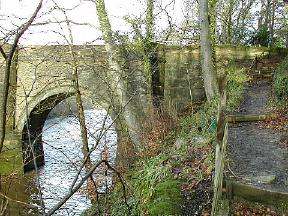 From the car park, cross Oswald’s Bridge, dating to 1826, over the River Ayr. At this point the river is broad and relatively shallow with well established woodland and grassland banks. The bridge is an excellent vantage point from which to scan the diverse and rich habitat. Turn left immediately down to the water’s edge and follow the path upstream through mixed woodland of Beech, Oak, Scots Pine and Japanese Larch. The opposite bank is open parkland. A steep climb away from the river leads to a track across open grassland surrounded by woodland with distant views of the Carrick Hills and Isle of Arran. Then re-enter woodland along the Waggonway Trail following the route of a 19th century railway linking inland coal pits to Ayr harbour, initially using horse drawn trucks and later steam locomotives. The path eventually climbs steeply to a spectacular viewpoint high above the river, reputed to be a favourite of Sir William Wallace of historic fame. The return to start is by a farm track over Loudon Law through a pastoral landscape of open views, very typical of much of Ayrshire.
From the car park, cross Oswald’s Bridge, dating to 1826, over the River Ayr. At this point the river is broad and relatively shallow with well established woodland and grassland banks. The bridge is an excellent vantage point from which to scan the diverse and rich habitat. Turn left immediately down to the water’s edge and follow the path upstream through mixed woodland of Beech, Oak, Scots Pine and Japanese Larch. The opposite bank is open parkland. A steep climb away from the river leads to a track across open grassland surrounded by woodland with distant views of the Carrick Hills and Isle of Arran. Then re-enter woodland along the Waggonway Trail following the route of a 19th century railway linking inland coal pits to Ayr harbour, initially using horse drawn trucks and later steam locomotives. The path eventually climbs steeply to a spectacular viewpoint high above the river, reputed to be a favourite of Sir William Wallace of historic fame. The return to start is by a farm track over Loudon Law through a pastoral landscape of open views, very typical of much of Ayrshire.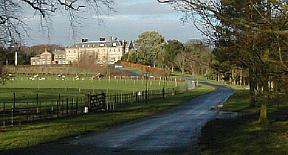 The large building visible up river from the car park and various points along the trail is Oswald Hall, built in 1767 to a design by Robert Adam. Oswald was a wealthy merchant who bought Auchincruive in 1764 and included among his accomplishments the role of chief negotiator during the War of American Independence, earning the nickname Richard the peacemaker. He rose from humble origins to a position of enormous wealth, largely as a result of his involvement in the slave trade – an unpleasant facet of his character – but, no doubt, simply a son of his time.
The large building visible up river from the car park and various points along the trail is Oswald Hall, built in 1767 to a design by Robert Adam. Oswald was a wealthy merchant who bought Auchincruive in 1764 and included among his accomplishments the role of chief negotiator during the War of American Independence, earning the nickname Richard the peacemaker. He rose from humble origins to a position of enormous wealth, largely as a result of his involvement in the slave trade – an unpleasant facet of his character – but, no doubt, simply a son of his time.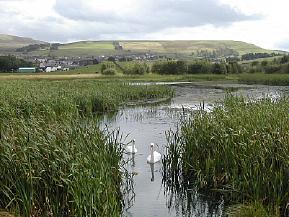
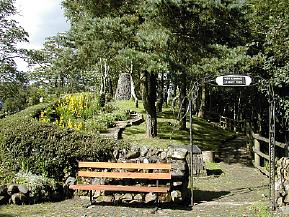 Flow gently, sweet Afton, among thy green braes!
Flow gently, sweet Afton, among thy green braes!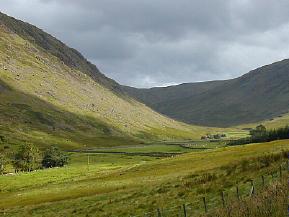 The glen is good for summer migrants, especially at the lower end where the trees are denser, including Whitethroat, Willow and Sedge Warbler, Redstart and Tree Pipit. Also present are Garden and Wood Warbler, Blackcap, Pied Flycatcher and Crossbill. Dipper, Common Sandpiper and Grey Wagtail frequent the burn and Buzzard breed well in the area.
The glen is good for summer migrants, especially at the lower end where the trees are denser, including Whitethroat, Willow and Sedge Warbler, Redstart and Tree Pipit. Also present are Garden and Wood Warbler, Blackcap, Pied Flycatcher and Crossbill. Dipper, Common Sandpiper and Grey Wagtail frequent the burn and Buzzard breed well in the area.